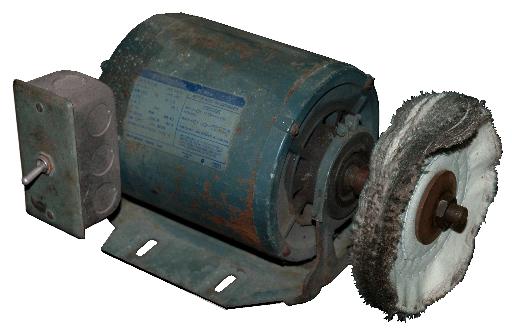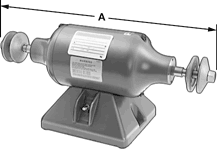MOTOR Polisher
Constructing a motor buffer/polisher:

In addition to a small bench grinder I have always tried to have a motor (1/3HP 1800 RPM) set up with a wire brush for light derusting and deburring.
The same setup can have the wire wheel replaced with a buffing wheel (as it does above) or a flap wheel.
NEVER put a hard (vitreous) grinding wheel on a setup like this as these can break and throw parts of the wheel with the violence of an explosion.
A motor mounted wheel such as the above must be mounted on the right hand corner of a bench or table.
The reason is that threaded arbors are generally only available with right hand threads.
With the wheel turning toward you (counter clockwise viewed from the end) the retaining nut is self tightening.
Otherwise the nut will quickly loosen and the wheel run off.
To mount on a left hand side (opposite the above) the motor MUST be fitted with a left hand thread arbor.
To build the above is a very simple task. You need the following parts.
- 1/3 HP single phase motor with 1/2" or 5/8" shaft. Cost $70 to $160.
- Switch enclosure, 1/2 close nipple, nut, switch and cord. Cost about $15.
- Threaded Motor Arbor. Cost $5.
- Wire wheel or buff. Cost $20, $5.
Costs
When I built the setup above about 1980 the U.S. made motor cost $50, the arbor $4 and the wire wheel $18 and power cord and switch $10.
Motors today are as much as triple what they were in 1980 but the other part have not changed much.
The motor used above is an open drip proof resilient mount (fan) motor.
The resilient mount is not necessary but is how fan motors are built.
You can save a lot if you find a good second hand motor.
These often sell for as little as $10-$15 at flea markets but can be a gamble.
I almost never have a shortage of cords for projects like this.
Any time we dispose of an appliance that has a grounded cord we cut the cord off and save it.

Note that if you pay the highest prices above it may be cheaper to purchase a purpose built buffer/polisher with TWO spindles such as the one to the left.
Cost is about $245 plus S&H from McMaster-Carr. Cost per spindle $123
Steps
- Attach the switch enclosure to the motor using a 1/2" conduit threaded nipple and one or more lock nuts.
NOTE that the switch may also be wall or cord mounted but I find this the most convenient.
- Fit the cord through a wire bushing or strain relief.
- Install the switch to one motor lead, the other side to the black wire of the cord.
- Connect the white cord wire to the second motor lead.
- Connect the green cord lead to a ground screw in the box or on the motor (green screw).
- Plug in and test the motor rotation direction. Normally it will be the right direction (CCW).
If not, follow the motor wiring instructions to reverse.
- Install the motor arbor with the set screw over the flat on the motor shaft and tighten the setscrew.
- Clamp or screw to the bench.
- Install wheel or buff tightening the arbor nut gently but securely.
- Fini
That is all there is to it.
Note that there is a significant difference between an 1800 RPM setup and 3600 grinder/buffer.
The slower speed cuts less and has a softer touch.
I prefer this for a lot of work.
Higher speed systems are also good but I prefer all wire brushes to run at the slower speed.
They shed wires bad enough at low speed and are much worse at high speed.
For buffing and sanding a variety of speeds is useful.
With a little more effort you can also build a pedestal mounted buffer.
This requires a pulley driven arbor shaft with bearings.
Occasionally these can be found in specialty shops. They used to be very common but good ones are difficult to find today.
Prices range from $30 for plain bearing models to double that for ball bearings.
The advantage to the pedestal stand is that it does not tie up bench space and can be more conveniently located.
Pedestals can be made from wood or metal.
For ideas on wood construction see Wayne Goddard's $50 Knife Shop.
Metal pedestals are easily made from heavy angle as the column with flanges for the top and bottom and a motor flange at the mid point.
Again, consider your costs.
Such things can be built very affordable or end up costing more than commercial equipment.
With a belt drive you can easily set the wheel surface speed to anything you want.
Links

MOTOR Polisher
Constructing a motor buffer/polisher:
A motor mounted wheel such as the above must be mounted on the right hand corner of a bench or table. The reason is that threaded arbors are generally only available with right hand threads. With the wheel turning toward you (counter clockwise viewed from the end) the retaining nut is self tightening. Otherwise the nut will quickly loosen and the wheel run off.
To mount on a left hand side (opposite the above) the motor MUST be fitted with a left hand thread arbor.
To build the above is a very simple task. You need the following parts.
- 1/3 HP single phase motor with 1/2" or 5/8" shaft. Cost $70 to $160.
- Switch enclosure, 1/2 close nipple, nut, switch and cord. Cost about $15.
- Threaded Motor Arbor. Cost $5.
- Wire wheel or buff. Cost $20, $5.
CostsWhen I built the setup above about 1980 the U.S. made motor cost $50, the arbor $4 and the wire wheel $18 and power cord and switch $10. Motors today are as much as triple what they were in 1980 but the other part have not changed much.

The motor used above is an open drip proof resilient mount (fan) motor. The resilient mount is not necessary but is how fan motors are built. You can save a lot if you find a good second hand motor. These often sell for as little as $10-$15 at flea markets but can be a gamble.
I almost never have a shortage of cords for projects like this. Any time we dispose of an appliance that has a grounded cord we cut the cord off and save it.
Note that if you pay the highest prices above it may be cheaper to purchase a purpose built buffer/polisher with TWO spindles such as the one to the left.
Cost is about $245 plus S&H from McMaster-Carr. Cost per spindle $123
Steps
- Attach the switch enclosure to the motor using a 1/2" conduit threaded nipple and one or more lock nuts.
NOTE that the switch may also be wall or cord mounted but I find this the most convenient.
- Fit the cord through a wire bushing or strain relief.
- Install the switch to one motor lead, the other side to the black wire of the cord.
- Connect the white cord wire to the second motor lead.
- Connect the green cord lead to a ground screw in the box or on the motor (green screw).
- Plug in and test the motor rotation direction. Normally it will be the right direction (CCW).
If not, follow the motor wiring instructions to reverse.
- Install the motor arbor with the set screw over the flat on the motor shaft and tighten the setscrew.
- Clamp or screw to the bench.
- Install wheel or buff tightening the arbor nut gently but securely.
- Fini
That is all there is to it.Note that there is a significant difference between an 1800 RPM setup and 3600 grinder/buffer. The slower speed cuts less and has a softer touch. I prefer this for a lot of work. Higher speed systems are also good but I prefer all wire brushes to run at the slower speed. They shed wires bad enough at low speed and are much worse at high speed. For buffing and sanding a variety of speeds is useful.
With a little more effort you can also build a pedestal mounted buffer. This requires a pulley driven arbor shaft with bearings. Occasionally these can be found in specialty shops. They used to be very common but good ones are difficult to find today. Prices range from $30 for plain bearing models to double that for ball bearings.
The advantage to the pedestal stand is that it does not tie up bench space and can be more conveniently located.
Pedestals can be made from wood or metal. For ideas on wood construction see Wayne Goddard's $50 Knife Shop. Metal pedestals are easily made from heavy angle as the column with flanges for the top and bottom and a motor flange at the mid point. Again, consider your costs. Such things can be built very affordable or end up costing more than commercial equipment. With a belt drive you can easily set the wheel surface speed to anything you want.
Links